Snake (sometimes also called Tunnel) is a spatial awareness path-finding logic puzzle. The aim is to connect the snake’s head with its tail by filling in grid cells following certain rules.
In a hurry? Jump to: Rules / Tips / Worked Example / Video Tutorial / Download Free Puzzles / Books
Here’s what a very easy Snake puzzle looks like:
The rules of Snake are easy to remember:
In easier level puzzles, every row and column is labelled. As the difficulty ramps up, some rows and columns are blank, making it harder to determine the snake’s path.
Here’s what our earlier example puzzle looks like once solved:
Solving these puzzles requires a combination of elimination and forced placement based on logical deduction. There is no single ‘correct’ way to solve a Snake puzzle, rather, you need to have a variety of techniques available to you.
Although the goal is to connect the snake’s head to its tail, there is no particular need to start at either the head or the tail; sometimes it makes more sense to start somewhere in the middle, solving different sections at a time until eventually they all link up.
Here are some tips to help you tackle Snake puzzles, then we’ll look at a worked example below.
We will work through a sample puzzle from beginning to end. As with all examples, remember that there’s no single path to the solution. This is just one way to get to the end.
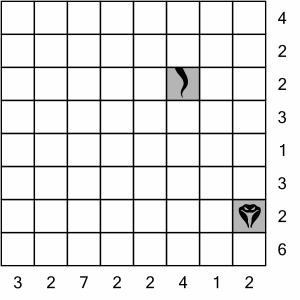
This is the Snake puzzle we are going to solve. At 8x8, and with every row and column labelled, it’s quite easy.
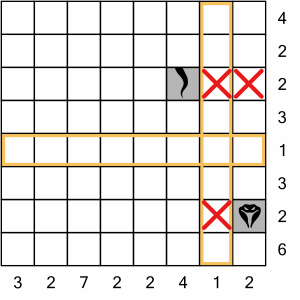
There are no extreme values on this 8x8 grid (no rows or columns labelled with a 0 or an 8).
We do however, have a ‘1’ row and a ‘1’ column. Because these are one-way crossings, it’s useful to highlight them. Once the snake’s body crosses each of these, there’s no turning back.
This allows us to immediately cross off three cells. The two to the right of the tail cannot be used, because it takes three cells to cross a ‘1’ column, and that would violate the 2 for that row. We can also eliminate the cell to the left of the head, for the same reason. That means the body extends from the head either up or down. Either way will allow us to fulfil the 2 clue for the column containing the head. Which way to go?
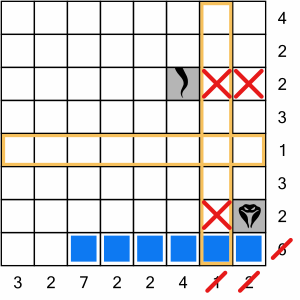
We have to go down. Why? Because the row above the head requires three cells to be filled in. Crossing the ‘1’ column would use our full complement. We would have to get back down to the bottom row to fill in the six cells that must be filled there, and that would violate the ‘2’ row, and the ‘3’ row on our way back. The only way to fill in the ‘6’ row is to go there directly from the head.
Once on the bottom row, we know we fill three cells to cross the one-way ‘1’ column. In fact, we can also deduce that we must place all six required cells in that row because there’s no valid way to leave the row and return. In other words, we couldn’t go across three cells, up a couple, across again, and back down, because that would violate the rows above.
This one move has completed a row and two columns for us. Where do we move next?
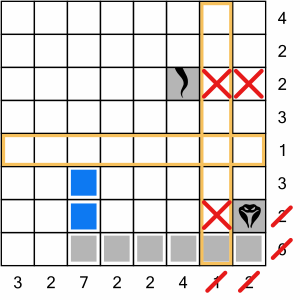
We know we have to move up the ‘7’ column, because we’ve filled the ‘6’ row. Going up one cell completes the ‘2’ row (with the head), so we must go up another cell – there’s no choice.
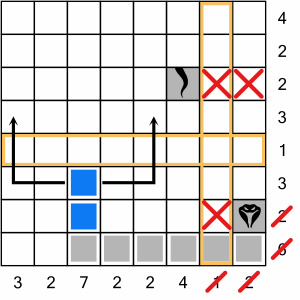
Now we do have a choice though. Because we have a one-way barrier ahead of us (the highlighted ‘1’ row), we know we must complete the ‘3’ row before moving upwards. So do we go left or right?
The one-way barrier means that once we turn upwards, we will have to continue for at least another two cells. Going right would violate the rules in two ways. Firstly, we would be filling three cells in a ‘2’ column. Secondly, we would end up touching the snake’s tail (diagonally). As the snake cannot touch itself, this would be an invalid move.
So we have to go left…
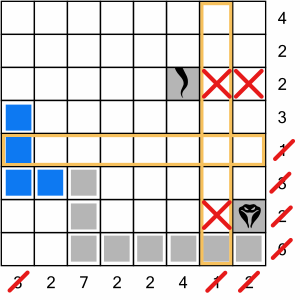
…then we have to cross our one-way barrier row by going up three cells, completing another column.
We can’t go up any more, so we have to go right…
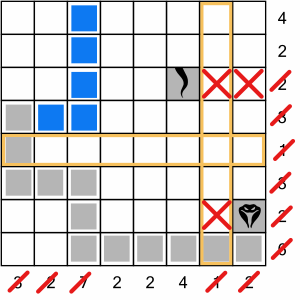
…and then upwards, because we’ve completed the three cells allowed in this row, and also because we have to complete our ‘7’ column. We’ve knocked off quite a few rows and columns now.
It’s a clear run to the end. We have to fill four cells in the top row, and there’s only one way to do that…
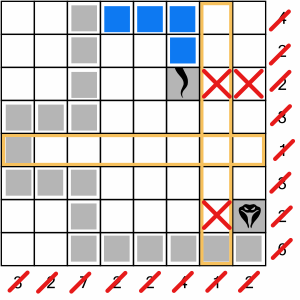
…which means we can drop down to the tail, completing the puzzle. Easy! Ready to have a go yourself? Read on!
We’ve put together a taster of four puzzles for you to try out, including the example above. You can download and print the PDF below. Solutions are included, but no cheating!
Finished the taster and want more Snake in your life? No problem! Get 120 carefully crafted puzzles set over seven levels in Puzzle Weekly Presents: Snake – it's great value!
We publish Snake puzzles in Puzzle Weekly from time to time. Puzzle Weekly is our free weekly puzzle magazine – find out more, and get your copy, here